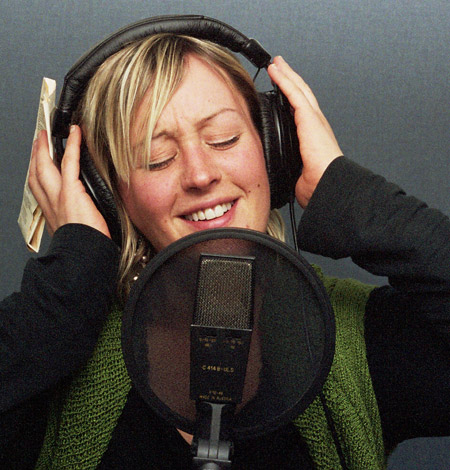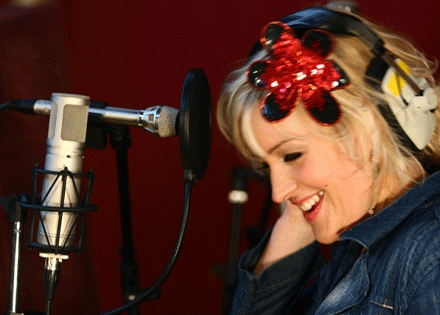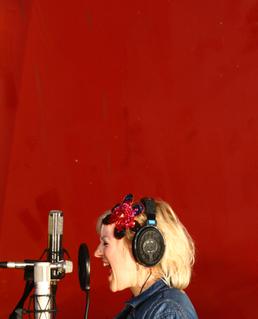ALICE RUSSELL / “Tired Little One”
I almost wish we could do this post without pictures so everyone reading this could have the same feeling I had when I first came across Alice Russell’s music. You see, the first time I heard Alice Russell, I thought she was black. Actually, that understates the case in two ways. First, I didn’t actually ‘think’ anything. It was so obvious that the voice I was listening to belonged to a modern-day soul sister, albeit one whose style harkened back to the glory days of the Seventies, that I never had to think about it all. Honestly, it never crossed my mind. If you look outside and see the sun, it’s daytime. You don’t think it’s daytime. It just is. Just like Alice was black.
The other thing is, it wasn’t just the first time. Meaning, I was about four or five good records deep with Alice before I finally figured it out. I first heard Alice sing a few years ago on a record she’d done with a frequent collaborator of hers, Will ‘Quantic’ Holland, a DJ and multi-instrumentalist out of Brighton, England. The record was “Sound Of Everything,” a looping, skipping, playful slice of pseudo-retro jazz (available on Quantic’s Mishaps Happening). I liked everything about the record, including Alice’s voice, but I would find out later that Alice was just laying in the cut on this one. She was fitting into the groove, not necessarily showing everything she had.
Not long after that, I heard the anthemic “Hurry On Now” (from Alice’s 2004 CD Under The Munka Moon). I liked the groove even before Alice started singing. But the moment that voice came in…! Man. I had to stop what I was doing to figure out exactly who and what I was listening to. She had a voice straight out of the black gospel church. She had that raw and bitter power that characterizes soul’s greatest female singers, women so known for their voices that the simple mention of their first names is enough to conjure up each of their distinctive sounds: Aretha, Roberta, Etta, Mavis, Chaka, Anita and yes, Teena. (Don’t sleep.) She also had an insistent way with her held notes, that bittersweet undertone as her voice faded away. It’s something that all the great soul singers have – though each in their own way - but it’s also something that’s becoming more and more rare.
I started looking for other Alice Russell tracks. I came across a gorgeous cover of “Feelin’ Good,” the tune made famous by Nina Simone (available on Quantic Soul Orchestra’s Pushin’ On). I came across a few other tracks I liked from Alice’s 2004 release Under The Munka Moon. My favorite had to be “Tired Little One,” mainly because of the spare arrangement. I love records like this one, records where the singer has nowhere to hide. Records where the instrumentalist is there only to pick out the chord changes, just to provide the most basic of frameworks. In this type of setting, the great singers thrive not by showing off how awesome their vocal gift is, but by quietly yet forcefully telling their story, singing their song.
After a while, I’d gotten my hands on enough Alice Russell tracks that I figured I might as well find out more about her. But first, I wondered what she looked like. I’d seen the cover art for Under The Munka Moon, but it’s a collage-style drawing. So I typed Alice’s name in the little Google box and clicked ‘images.’ That didn’t work. One of the problems with Google is it doesn’t actually ‘know’ what you’re looking for. Instead of getting pictures of Alice Russell the soul singer, I got pictures of a happy-looking blonde-haired white girl. I fleetingly wondered what this other Alice Russell might be known for, then went back to Google to refine my search. Next to ‘Alice Russell’ I added ‘singer’ and ‘music.’ I was surprised – ok, shocked – when I got back the same images, including, I now noticed, the cover art for Alice’s second album My Favourite Letters which contains another song I like a lot, “I’m Just Here.” I sat there staring at my computer screen in disbelief. There she was: Alice Russell in all her fresh-scrubbed, bright-eyed blonde glory.
At first, I’m embarrassed to say, I started hearing Alice’s records a little differently. I’d hear a little something in this note or that one which ‘betrayed’ her whiteness. I’d imagine that some lyric or the other ‘revealed’ that she was actually from Suffolk, England as opposed to Detroit, Michigan or Memphis, Tennessee. Basically (although I didn’t see it then) I was exposing my own prejudices. In retrospect, it was a fairly sad and pitiful experience.
Luckily, I have this CD I’d made of classic soul vocalists mixed with current vocalists who have that same classic style. I love that CD. Where else could I hear a great old record by an Irma Thomas or Freda Payne butted up against a modern gem by Jill Scott or Conya Doss? I was at the end of the CD when Alice’s “Get Ready In The Morning” came on (available on Under The Munka Moon). I’d just finished listening to over an hour of some of soul music’s greatest female singers, and you know what? Alice fit right in, almost like she was one of them. By the time the song ended, I realized why. It’s because she is one of them. Do your thing Alice.
—Mtume ya Salaam
Before I Saw You
That was a line credited to jazz musician Archie Shepp. Allegedly Archie was giving an assessment of trombonist Roswell Rudd, who would in time go on to become a longstanding member of Archie’s band in the Seventies. In a withering and self-deprecating moment of critical reflection, Archie opined: “I liked you a lot better before I saw you.”
Yeah, Mtume, you are right. All of us have to work through our prejudices. We have to get pass the American tendency to define human activity in terms of race, especially given that our “race” is, by definition, mixed. Biological essentialism is what it’s sometimes called.
You know, of course, England has a truckload of white soul singers, a number of whom are blond and female. Joss Stone is the current incarnation sweeping America, but going back to the Eighties you had Lisa Stansfield.
But back to Alice; she’s got “it.” The real question, at least for me, will be can she sustain the it that she’s got? Can she find and work with producers and musicians who will offer her not just an appropriate setting to present herself, but who will challenge her to higher heights? The biggest problem when you are crossing cultures is that you might be isolated and prevented from working with peers and masters of your chosen artform, peers and masters who will challenge you even as they nurture you, peers and masters from whom you can learn and by whom you can be inspired.
A lot of times it’s the no name cats who make the biggest difference. By "no name" I mean the thousands of musicians who are known within music circles but are relatively unknown to the general public. These are the people who are the fertile ground out of which blossoms great artists. Just as no one can attain deeptitude without serious roots, in a similar way barren ground can not produce sweet fruit.
We often take our cultural context for granted. You know how people refer to “the church” as though it was some college you go to to learn how to sing soulfully? We don’t think about the seminal importance of community-based cultural institutions, but particularly when we are making a critical analysis, we need to acknowledge the individuals and institutions that are the hotbed out of which rises our major musical movers.
Alice’s work, her voice and vision, has earned her admittance to the sacred circle of ancestral and contemporary musical masters, the sacred circle within which she can grow and develop. That’s what I hope she receives so that she can keep on achieving. Obviously she is interested in being a soul singer, but there is no such thing as a solitary soul. Soul is a collective identity/expression.
—Kalamu ya Salaam
P.S. She reminds me of New Zealand’s Hollie Smith, as does your reaction, Mtume, to the New Zealand folk. Just goes to show you: it is possible for anyone to dig a tunnel and connect to that great hole in the earth whose origin is Africa but whose concourses stretch beneath every place where there are humans who are prepared to study and identify with what we know as the sound of soul. As far as I am concerned, “Get Ready In the Morning” is Alice’s calling card.
Also, I am adding two tracks to the mix:
1. “A Fly In The Hand” from Alice's second solo CD, My Favourite Letters.
2. An audio of "To Know This" from a live video project. A studio version of the track is available on My Favourite Letters.
“Fly” is in an electronic funky vein and “I’m Free” is jazz oriented.
This entry was posted on Sunday, March 18th, 2007 at 1:51 am and is filed under Contemporary. You can follow any responses to this entry through the RSS 2.0 feed. You can leave a response, or trackback from your own site.
2 Responses to “ALICE RUSSELL / “Tired Little One””
March 18th, 2007 at 8:43 pm
I first heard this on some deep house vinyl (of the very well produced and finished variety). It didn’t have that remix feel and I assumed it was an original work. The way these things work I’m not sure which is the ‘cover’. Check her other stuff with the Bah Sambah collective:
http://www.discogs.com/artist/Bah+Samba
nice.
Leave a Reply
| top |